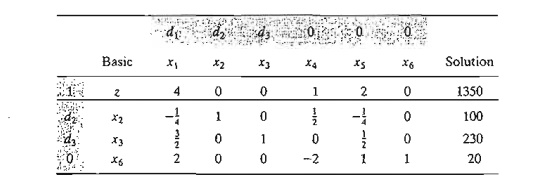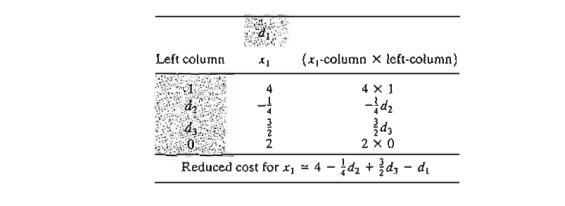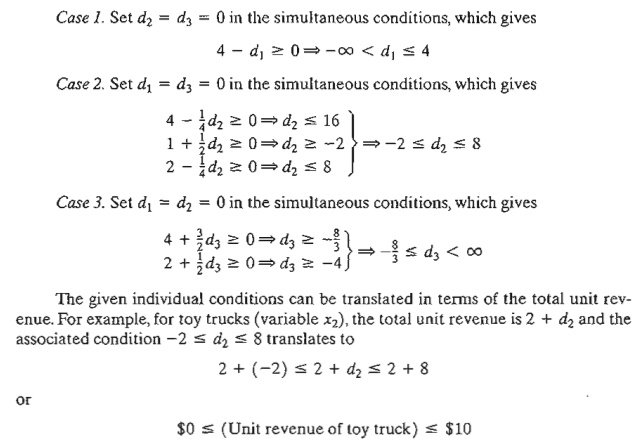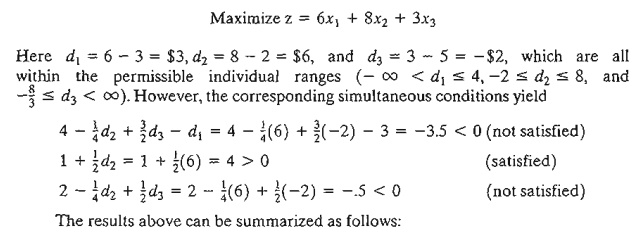Chapter: Operations Research: An Introduction : The Simplex Method and Sensitivity Analysis
Algebraic Sensitivity Analysis-objective Function
Algebraic Sensitivity Analysis-objective Function
In Previous Section we used graphical sensitivity analysis to determine the conditions that
will maintain the optimality of a two-variable LP solution. In this section, we
extend these ideas to the general LP problem.
Definition
of Reduced Cost. To facilitate the explanation of the objective
function sensitivity analysis, first we need to define reduced costs. In the TOYCO model (Example 3.6-2), the objective
z-equation in the optimal tableau is

The
optimal solution does not recommend the production of toy trains (xl
= 0). This recommendation is confirmed by the informatIon in the z-equation
because each unit increase in Xl above its current zero level will decrease the
value of z by $4 - namely, z = 1350 - 4
X (1) - 1 x (0) - 2 X (0) = $1346.
We can think of the coefficient of xl in
the z-equation (= 4) as a unit cost
be-cause it causes a reduction in the revenue z. But where does this "cost" come from? We know that xl
has a unit revenue of $3 in the original model. We also know that each toy
train consumes resources (operations time), which in turn incur cost. Thus, the
"attractiveness" of x1 from the standpoint of
optimization depends on the relative values of the revenue per unit and the
cost of the resources consumed by one unit. This relation-ship is formalized in
the LP literature by defining the reduced cost as

To
appreciate the significance of this definition, in the original TOYCO model the
revenue per unit for toy trucks (= $2) is less than that for toy trains (= $3). Yet the optimal solution
elects to manufacture toy trucks (x2
= 100 units) and no toy trains (x1 = 0). The
reason for this (seemingly nonintuitive) result is that the unit cost of the resources
used by toy trucks (i.e., operations time) is smaller than its unit price. The
op-posite applies in the case of toy trains.
With the
given definition of reduced cost we
can now see that an unprofitable variable (such as Xl) can be made profitable
in two ways:
1. By
increasing the unit revenue.
2. By
decreasing the unit cost of consumed resources.
In most real-life
situations, the price per unit may not be a viable option because its value is
dictated by market conditions. The real option then is to reduce the
consump-tion of resources, perhaps by making the production process more
efficient, as will be shown in Chapter 4.
Determination of the Optimality Ranges. We now
turn our attention to determining the conditions that will keep an optimal
solution unchanged. The presentation is based on the definition of reduced cost.
In the
TOYCO model, let d1 d2, and d3 represent the change in unit revenues for toy trucks,
trains, and cars, respectively. The objective function then becomes

As we did
for the right-hand side sensitivity analysis in Section 3.6.2, we will first
deal with the general situation in which all the coefficients of the objective
function are changed simultaneously
and then specialize the results to the one-at-a-time case.
With the
simultaneous changes, the z-row in the starting tableau appears
as:

When we generate
the simplex tableaus using the same sequence of entering and leaving variables
in the original model (before the changes d
j are
introduced), the op-timal iteration will appear as follows (convince yourself
that this is indeed the case by carrying out the simplex row operations):

The new
optimal tableau is exactly the same as in the original optimal tableau except that the reduced costs (z-equation coefficients) have changed. This means
that changes in the objective-function
coefficients can affect the optimality of the problem only.
You really do not need to carry
out the row operation to compute the new reduced costs. An examination of the
new z-row shows that the coefficients of di are taken directly from the
constraint coefficients of the optimum tableau. A convenient way for computing
the new reduced cost is to add a new top row and a new leftmost column to the
optimum tableau, as shown by the shaded areas below. The entries in the top row
are the change d i
associated with each variable. For the leftmost column, the entries are 1 in
the z-row and the associated di
in the row of each basic variable. Keep in mind that d i = 0 for the slack variables.

Now, to compute the new reduced
cost for any variable (or the value of z), multiply the elements of its column
by the corresponding elements in the leftmost column, add them up, and subtract
the top-row element from the sum. For example, for xl, we have

Note that
the application of these computations to the basic variables will always pro-duce a zero reduced cost, a proven
theoretical result. Also, applying the same rule to the Solution column produces z
= 1350 + 100d2 + 230d3.
Because we are dealing with a
maximization problem, the current solution re-mains optimal so long as the new
reduced costs (z-equation coefficients) remain non-negative for all the
nonbasic variables. We thus have the following optimality conditions corresponding to nonbasic x1
x4, and x5

These conditions
must be satisfied simultaneously to
maintain the optimality of the current optimum.
To illustrate the use of these
conditions, suppose that the objective function of TOYCO is changed from

The results show that the
proposed changes will keep the current solution (x1 = 0,
x2 = 100, x3 = 230) optimal. Hence no further
calculations are needed, except that the objective value will change to z = 1350 + 100d2 + 230d3 = 1350 + 100 X -1 + 230 X 1 = $1480. If any of the conditions is not
satisfied, a new solution must be de-termined (see Chapter 4).
The
discussion so far has dealt with the maximization case. The only difference in
the minimization case is that the reduced costs (z-equations coefficients) must
be ≤ 0 to maintain optimality.
The
general optimality conditions can be used to determine the special case where
the changes d j occur one at
a time
instead of simultaneously. This analysis is equivalent to considering the
following three cases:

The individual conditions can be accounted for as special cases of the simultaneous case.

This
condition assumes that the unit revenues for toy trains and toy cars remain
fixed at $3 and $5, respectively.
The
allowable range ($0, $10) indicates that the unit revenue of toy trucks
(vari-able xz) can be as low as $0 or as high as $10 without changing the
current optimum, x1 = 0, x2 = 100, x3 = 230.
The total revenue will change to 1350 + 100d2, however.
It is important to notice that the
changes d1,
d2,
and d3 may be within their allow-able
individual ranges without satisfying the simultaneous conditions, and vice
versa. For example, consider

1.The
optimal values of the variables remain unchanged so long as the changes dj , j =
1, 2, ...
,
n, in the objective function
coefficients satisfy all the optimality conditions when the changes are
simultaneous or fall within the optimality ranges when a change is made
individually_
2. For
other situations where the simultaneous optimality conditions are not satisfied
or the individual feasibility ranges are violated, the recourse is to either
re-solve the problem with the new values of dj or apply the post-optimal
analysis presented in Chapter 4.
PROBLEM
SET 3.60
1. In the
TOYCO model, determine if the
current solution will change in each of the following cases:

*2.
B&K grocery store sells three types of soft drinks: the brand names Al Cola
and A2 Cola and the cheaper store brand BK Cola. The price per can for Al, A2,
and BK are 80, 70, and 60 cents, respectively. On the average, the store sells
no more than 500 cans of all colas a day. Although Al is a recognized brand
name, customers tend to buy more A2 and BK because they are cheaper. It is
estimated that at least 100 cans of Al are sold daily and that A2 and BK
combined outsell Al by a margin of at least 4:2.
a.Show that the optimum solution does not call for selling the A3 brand.
b.By how much should the price per can of A3 be increased to be sold by
B&K?
c.To be competitive with other stores, B&K decided to lower the
price on all three types of cola by 5 cents per can. Recompute the reduced
costs to determine if this promotion will change the current optimum solution.
3. Baba
Furniture Company employs four carpenters for 10 days to assemble tables and
chairs. It takes 2 person-hours to assemble
a table and .5 person-hour to assemble a chair. Customers usually buy one table
and four to six chairs. The prices are $135 per table and $50 per chair. The
company operates one 8-hour shift a day.
a. Determine
the 10-day optimal production mix.
b. If the present unit prices per table
and chair are each reduced by 10%, use sensitivi-ty analysis to determine if
the optimum solution obtained in (a) will change.
c. If the present unit prices per table
and chair are changed to $120 and $,25, will the solution
in (a) change?
4. The
Bank of Elkins is allocating a maximum of $200,000 for personal and car loans
dur-ing the next month. The bank charges 14% for personal loans and 12% for car
loans. Both types of loans are repaid at the end of a I-year period. Experience
shows that about 3 % of personal loans and 2 % of car loans are not repaid. The
bank usually allocates at least twice as much to car loans as to personal
loans.
a.
Determine the optimal allocation of funds between
the two loans and the net rate of return on all the loans.
b.
If the
percentages of personal and car loans are changed to 4% and 3%, respectively, use sensitivity analysis to
determine jf the
optimum solution in (a) will change.
*5.
Electra produces four types of electric motors, each on a separate assembly
line. The re-spective capacities of the lines are 500, 500, 800, and 750 motors
per day. Type 1 motor uses 8 units of a certain electronic component, type 2
motor uses 5 units, type 3 motor uses 4 units, and type 4 motor uses 6 units.
The supplier of the component can provide 8000 pieces a day. The prices per
motor for the respective types are $60, $40, $25, $30.
a) Determine
the optimum daily production mix.
b) The
present production schedule meets Electra's needs. However, because of competition,
Electra may need to lower the price of type 2 motor. What is the most
re-duction that can be effected without changing the present production
schedule?
c) Electra
has decided to slash the price of all motor types by 25%. Use sensitivity
analysis to determine if the optimum solution remains unchanged.
d) Currently,
type 4 motor is not produced. By how much should its price be increased to be
induded in the production schedule?
6. Popeye
Canning is contracted to receive daily 60,000 lb of ripe tomatoes at 7 cents
per pound from which it produces canned tomato juice, tomato sauce, and tomato
paste. The canned products are packaged in 24-can cases. A can of juice uses
lib of fresh tomatoes, a can of sauce uses 3/4 lb, and
a can of paste uses ½ lb. The company's daily share of the market is
limited to 2000 cases of juice, 5000 cases of sauce, and 6000 cases of paste.
The wholesale prices per case of juice, sauce, and paste are $21, $9, and $12,
respectively.
a.
Develop an optimum daily production program for
Popeye.
b.
If the price
per case for juice and paste remains fixed as given in the problem, use sensitivity analysis to determine
the unit price range Popeye should charge for a case of sauce to keep the
optimum product mix unchanged.
7. Dean's
Furniture Company assembles regular and deluxe kitchen cabinets from precut lumber.
The regular cabinets are painted white, and the deluxe are varnished. Both
paint-ing and varnishing are carried out in one department. The daily capacity
of the assembly department is 200 regular cabinets and 150 deluxe. Varnishing a
deluxe unit takes twice as much time as painting a regular one. If the painting/varnishing
department is dedicat-ed to the deluxe units only, it can complete 180 units
daily. The company estimates that the revenues per unit for the regular and
deluxe cabinets are $100 and $140, respectively.
a.
Formulate the problem as a linear program and find
the optimal production sched-ule per day.
b.
Suppose that competition dictates that the price
per unit of each of regular and deluxe cabinets be reduced to $80. Use
sensitivity analysis to determine whether or not the optimum solution in (a)
remains unchanged.
Related Topics